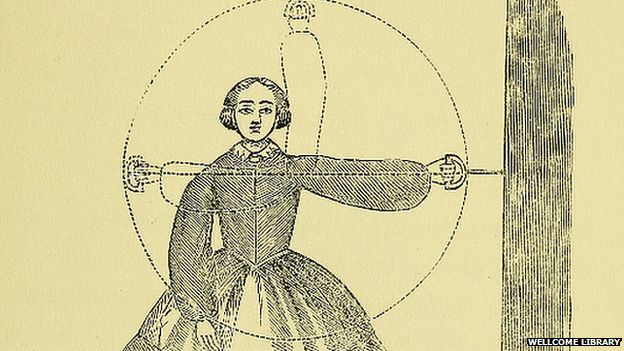Victorian keep-fit exercises and gym regimes revealed
- Published

The idea of buying fancy fitness equipment and smugly installing it in a corner at home may not be just the modern-day craze some would expect.
A leather-bound book written in 1861, found in the archives of London's Wellcome Library, describes a portable gymnasium for the discerning Victorian.
The manual shows women in full, puffy petticoats and tight-fitting bodices attempting activities such as leg extensions, downward traction, jumping exercises and chest expansions.
And the men are resplendent in long coats, shirts and accompanying neckties, looking remarkably dapper as they work up a sweat.
This comprehensive series of exercises was recommended by Gustav Ernst, an orthopaedic machinist based in London, who invented the portable home gym.
The apparatus, consisting of wooden boards of the finest mahogany with various pulleys, weights and cords attached, was designed for families wishing to reap the benefits of exercise and people with spinal problems.
Ernst offered encouragement to those reluctant to step up to the daily regime, suggesting that although the activities may have been "devoid of all interest and reduced to a mere display of physical power", there were substantial gains to be made.
Of course this contraption would have only been available to those rich enough to have the luxury of spare time, according to Dr Vanessa Heggie, a health historian at Birmingham University.
The masses were more likely to partake in involuntarily vigorous activity - through hard manual labour.
But some of the exercises seem quite like gym techniques now.
"I'm surprised quite how similar this contraption is to a modern-day cable machine," said Julia Attias, a personal trainer and exercise physiologist.
"There are some exercises in this book I still use today - though, of course, with a few safety modifications."
Ernst recommended short bursts of training, suggesting: "Far more benefit is to be derived from a quarter of an hour's practice repeated four times a day than from one hour's continuous use."
The most powerful exercise mentioned in the book is described as combined traction and extension.
And the accompanying illustration shows a skirted woman straining her arms on something akin to the modern-day cross-trainer.
The author suggested this worked all the muscles of the human frame.
But he did voice some rare health-and-safety concerns, saying: "Generally invigorating as this exercise is, it is correspondingly fatiguing and should not therefore be recklessly persevered, especially by pupils possessing but a small amount of physical strength."
And though gym equipment may be shinier and safer today, the idea of maintaining physical fitness spans thousands of years.
According to research by Prof Domhall MacAuley of the University of Ulster, Hua T'o, a legend of ancient Chinese surgery, encouraged exercises modelled on the movements of animals, dating as far back as 2500 BC.
And the ancient Olympics, thought to have started around 776 BC, are considered by many to mark the birth of professional athletics.
But it is often a German, Friedrich Ludwig Jahn, who is credited as the father of gymnastics and gym equipment, designing parallel bars and the balance beam in the early 19th Century.
Long before Jane Fonda, Mr Motivator and Shaun T, there seems to be a long line of people we can thank for the often unrelenting call to tone those muscles.